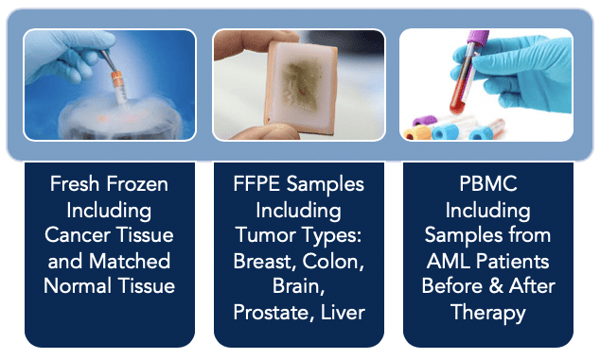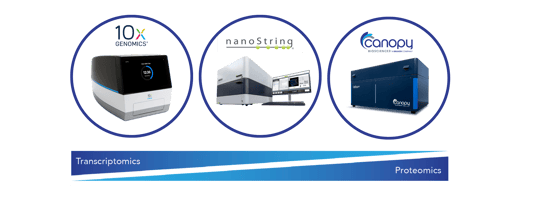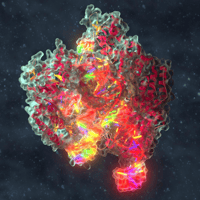The Basics of Breakthroughs: Approaches in Single-Cell Analysis
Three Things You Should Consider When Sourcing Samples
Three Things You Should Consider When Sourcing Samples
Quality data begins with the best samples. Sample procurement can be a challenge for many researchers, especially if one is unfamiliar with the specific options or with the current network of biological sample providers. That’s why we’ve put together 3 things you should consider when it comes to sourcing samples for your next project.
1. Discuss the details of your sample needs upfront.
All of your sample procurement projects should begin with a conversation. Don’t just place your order and hope for the best. There are many details to consider when choosing your samples: sample format, sample age, sample volume or area, treatment history, etc. You may also want to ask whether there are any matched samples available. For example, if you are currently needing a tissue samples, it could be worth asking whether the provider also currently has a matched serum or PBMC sample to the tissue. Your provider should be eager to understand the sample criteria that are critical to your study. You should also ask whether they can provide the clinical details of the sample prior to purchase to ensure that it’s exactly what you need. Finally, make sure to ask about the lead time for your samples. Even though the samples are technically off-the -shelf, it can take time to retrieve the sample from it’s current storage facility and do a quality check before shipping it out. This can often add 1-2 weeks of lead time.
In short, think about the details of your sample needs upfront as much as you are thinking about the experiments that you will do with these samples.
2. Consider sourcing from multiple sample providers.
Relying on a sole provider is not ideal because many sample providers specialize in certain therapeutic areas or sample formats. It’s definitely worth doing some research on different sample providers to understand their niche in sample procurement. Sample providers can have various relationships with collection sites that allow them to provide certain types of samples that would otherwise be difficult to acquire. You may want to call on one provider for your checkpoint inhibitor treated samples and another provider for your virus-infected samples. Also, with some research, you can learn the specialization in terms of sample formats of the many providers. For example, some providers only have FFPE tissues but do not provide fresh frozen tissue options. Sample format information can be especially important when you need higher sample numbers. It can save a lot of time during the procurement process.
The point is to not rely on the same provider every time you need samples; it’s usually worth the effort to contact multiple providers and do your research even before you need the samples.
3. Consider outsourcing your sample procurement needs.
Presumably, you are thinking about acquiring samples for a downstream assay/analysis. CROs like Canopy, who provide various downstream services, are regularly sourcing samples for projects. Obviously, this could help to streamline the project by having the samples sourced by the same CRO who will need them to perform downstream services, but there are multiple other benefits to this approach. An outsourced provider of sample procurement can help make sure that you ask the right questions upfront, and they will have a network of connections to sample providers. Not only can this save time because you won’t have to do the research yourself, but CROs who are regularly sourcing tissue will also have direct contacts to the sample providers. This is important because samples listed on a website are almost always outdated. You need to connect directly with the provider to make sure you have access to all currently available samples. While these conversations require more time, you can also learn very valuable information about certain samples, or even better, you might learn of samples that are in the pipeline but aren’t yet on the list. If you are outsourcing your sample procurement, these conversations with sample providers are something that can be done for you.
Finally, the CRO who will be processing the samples understands how differences in format and overall quality affect final results. Whether it’s IHC on tissue or RNA isolation for RNA-seq, involving your analysis CRO in the procurement process can help to ensure you are asking the right questions and talking to the right people. Taken together, there are definite benefits to having a partner that will help make sure that you get the best possible samples for your project.
Let's work together.
While it might seem like a simple task, sample procurement can take some time to do the necessary research. Connecting with each provider and knowing what questions to ask upfront can make all the difference. This is where Canopy can help. Our experience and direct connections to the most trusted sample providers mean less frustration for scientists in making sure the experiment starts with the right samples. Even better, Canopy’s portfolio of downstream service offerings—such as immune profiling, NanoString, RNAseq, and multiplexed tissue analysis—means that we can help to streamline your next study from sample to data analysis. You can work with a single company to ensure the best possible answers.

The image above includes 3 examples of sample procurement projects. If you are interested in learning more about Canopy’s sample procurement services, please reach out to your local business development representative or contact us today at info@canopybiosciences.com.




